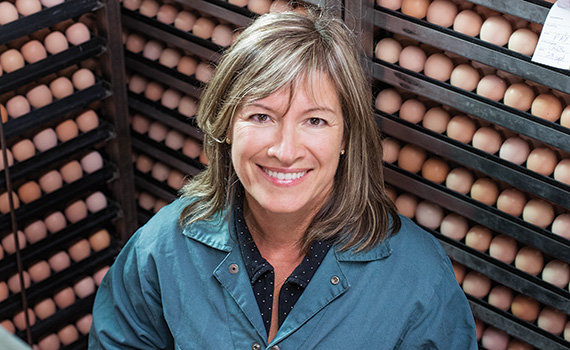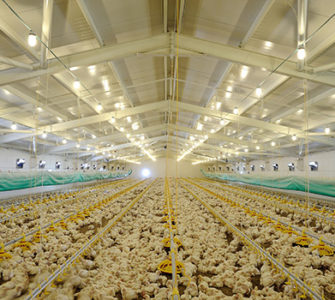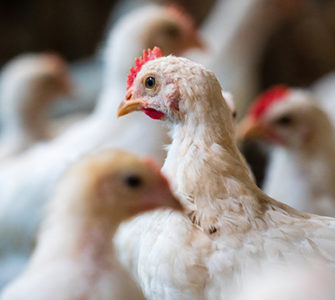Broiler study shows challenges and potential of drug-free production
 Broilers raised in a drug-free program had a higher feed-conversion ratio (FCR), decreased mean daily weight and decreased mean live marketing weight despite administration of antibiotic alternatives, according to study results presented at the 2015 annual meeting of the American Association of Avian Pathologists (AAAP).
Broilers raised in a drug-free program had a higher feed-conversion ratio (FCR), decreased mean daily weight and decreased mean live marketing weight despite administration of antibiotic alternatives, according to study results presented at the 2015 annual meeting of the American Association of Avian Pathologists (AAAP).
The 14-month study involved over 1.5 million birds and was conducted on eight commercial broiler farms in Quebec. The Canadian researchers compared the performance of 51 drug-free flocks with the performance of 51 traditionally raised paired flocks, reported Martine Boulianne, DVM, PhD, chair of poultry research at the University of Montreal.
Antibiotic alternatives
For the drug-free flocks, the researchers replaced anticoccidials and so-called performance antibiotics — that is, antibiotics with claims for increased feed conversion and weight gain — with coccidiosis vaccination, improved brooding conditions, water acidification and an in-feed antibiotic alternative. The antibiotic alternative was one of three commercially available essential-oil-based products, the veterinarian said of the study, published in the August 2015 issue of Poultry Science.1
Improved brooding for the drug-free flocks included 3 to 4 inches of fresh bedding, preheated housing and clean, flushed and sanitized water lines — all accomplished before chicks were placed. Stocking density ranged from 26 kg of live chickens per square meter (57.3 lbs per 3.2 square feet) to less than 31 kg per square meter (68.3 lbs per 3.2 square feet).
The drug-free flocks also had additional paper feeders and feed boxes and even new light bulbs (60 to 100 lux) to ensure appropriate lighting conditions above feeders and drinkers for the first 48 hours after placement. The researchers monitored chick body temperatures and crop filling 24 hours after chick placement and adjusted ambient temperatures as needed, she said.
Traditional program
Traditionally raised flocks in the study received anticoccidials and performance antibiotics in feed according to their respective feed mill’s program, but there were no specific recommendations given regarding brooding protocol or water acidification, Boulianne said.
Producers and others involved in the study were blinded about the alternative products administered to minimize potential bias about the results, she noted. Although the drug-free broilers had a statistically significant lower mean daily weight gain, lower mean final weight and a higher FCR, their livability, age at marketing or percentage of total condemnations did not differ significantly from the traditionally raised birds (Figure 1), Boulianne said.
NE outbreaks
More than 27% of the 51 drug-free flocks experienced a clinical necrotic enteritis (NE) outbreak and more than 49% developed subclinical enteritis, while none of the traditional flocks had enteritis-related clinical signs. flocks with NE were rapidly treated with essential-oil-based products in water, and for severe NE outbreaks, antibiotic therapy was administered, Boulianne and colleagues noted in their published report.
“It is noteworthy…that from the eight participating farms, recurrent NE outbreaks were observed for all drug-free flocks from two specific farms,” they said.
The 3.37% increase in fcr for birds in the drug-free group is slightly higher than what’s been reported in European studies but could be explained by the continued use of ionophores in Europe, the researchers said. Clostridium perfringens, which can occur secondary to coccidiosis, is thought to be less of a problem when ionophores are used since the drugs contribute to better overall gut health by keeping coccidia in check.
Additional findings
Mean microscopic intestinal lesion scores and the prevalence of Campylobacter colonization were not statistically different between the drug-free and traditionally raised broilers, but the researchers isolated higher rates of C. perfringens from the drug-free birds. They found no significant differences among the three essential-oil products used in the study.
Litter-moisture control was an ongoing challenge in drug-free flocks and was especially problematic the last 2 weeks of rearing. Wet litter may be linked to an altered digestive function and be a consequence of clinical and subclinical NE, they noted.
In other ways, however, drug-free flocks in the study had fewer performance losses than reported in previous studies among birds raised without antibiotics, which might be explained by the use of a coccidiosis vaccine, the essential-oil-based products as well as early feeding, which was facilitated by improved brooding conditions, the researchers said.
At the AAAP meeting, Boulianne said the results underscore the importance of optimal brooding. However, “even with standardization of rearing methods and other parameters, rearing drug-free birds had a negative impact on gut health for many farms.
“While we feel that we might have a part of the solution to control [or] reduce NE, further investigation is warranted to better understand the role [and] involvement of Clostridium perfringens in the pathogenesis of subclinical enteritis,” Boulianne said.
1 Gaucher M-l, et al. Impact of a drug-free program on broiler chicken growth performances, gut health, Clostridium perfringens and Campylobacter jejuni occurrences at the farm level. Poult Sci. 2015 August;94(8):1791-1801.
Feature photo courtesy of Christian Fleury, University of Montreal
Posted on July 8, 2016


















